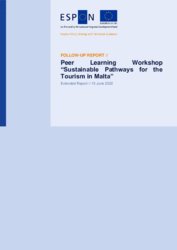TOURISM - Carrying capacity methodology for tourism
Scope
The main objective of this service contract is to provide an empirical foundation for destinations and help local leaders assess their situation and identify vulnerabilities in relation to sustainable tourism in the respective territories. This foundation would enable the analysis of carrying capacity for tourism based on innovative and available indicators, including tourist arrivals, internet data, social media reviews, seasonality, and pollution with use of big data, new technologies, artificial intelligence and high-performance computing (HPC) to be applied to the management of any European tourist destination.
The project will also provide recommendations mainly to regional and local practitioners, as well as European, on how to identify and consider their specific territorial context and specificities for measurement of the carrying capacities of tourist destinations across Europe for better management and planning.
Stakeholders’ knowledge needs
- How to approach carrying capacities considering the growing number of tourists in many destinations?
- What conceptual framework, methodology and assessment tools can be developed and/or applied for measuring carrying capacity and tourist flows?
- What are the different data sources and what related data sets/indicators can be collected and used to measure and compare carrying capacities in tourism?
- How these can directly contribute to better decisions of local authorities for sustainable tourism development? In particular in the stakeholders' territories (including unconventional and big data sources)?
- What are the possibilities and methodologies for using alternative data sources and new technologies (such as big data analysis, analytical intelligence, could computing, sensors) for measuring carrying capacity (including tourist flows)?
- How can tourist flows in relation to carrying capacity be visualised interactively using alternative data sources?
- What are the main policy recommendations in the study area and in the case studies that can be given to practitioners to measure the carrying tourist capacity of their territories?
Main outcomes
- Overview of existing methodologies for measuring the carrying capacity of tourist destinations.
- Identification of data sources, including innovative methods and alternative data sources and tools for measuring tourist flows and their satisfaction.
- Development of a methodology making use of new technologies and alternative data sources for measuring tourist capacity for each different type of stakeholders (municipalities, cities, regions…) and by considering the specific characteristics of the territories and their own vulnerabilities. This should also include an interactive visualisation of tourist flows representing the number of tourists in relation to the three sustainable pillars of sustainability (and corresponding data and indicators).
- Territorial evidence based on the methodology developed on the carrying capacity of territories and tourist flows in Europe, encompassing approximately 50 municipalities partners from Croatia and Slovenia and one cross-border city area Nova Gorica (Slovenia) – Gorizia (Italy). In this sense, the methodology and indicators proposed shall consider the three pillars of sustainability - economic, environmental and social, granting a clear approach towards decision-making.
- Detailed case studies in the stakeholders’ territories (including identification and analysis of local data sources, a set of maps, practical examples and policy recommendations to answer stakeholders’ needs…). This should include a practical application of the methodology developed.
- Policy recommendations to provide appropriate support to measure carrying capacity in the stakeholders’ territories and in other European municipalities, cities and regions.
Spin-off
- Case Study Malta. See follow-up reports below.
Stakeholders
- Ministry of Economic Development and Technology in Slovenia (SI) – lead stakeholder
- INFORMEST: Service and Documentation Centre for International Economic Cooperation (IT)
- Municipality of Bled (SI)
- Association of cities of the Republic of Croatia (HR)
- Municipality of Brežice (SI)
- Association of municipalities and towns of Slovenia (SI)
- Municipality of Divača (SI)
Contractors
- ÖIR Gmbh, AT (lead contractor)
- MODUL University Vienna, AT
- University of Ljubljana, SI
Budget
€ 274.000,00
Lifetime
November 2019 – November 2020
Deliveries
- Inception delivery : 11 December 2019
- Interim delivery : 11 June 2020
- Final delivery : 11 November 2020
Contact
Sandra Di Biaggio (Senior Project Expert) [email protected], György Alfoldy (Financial Expert) [email protected]







